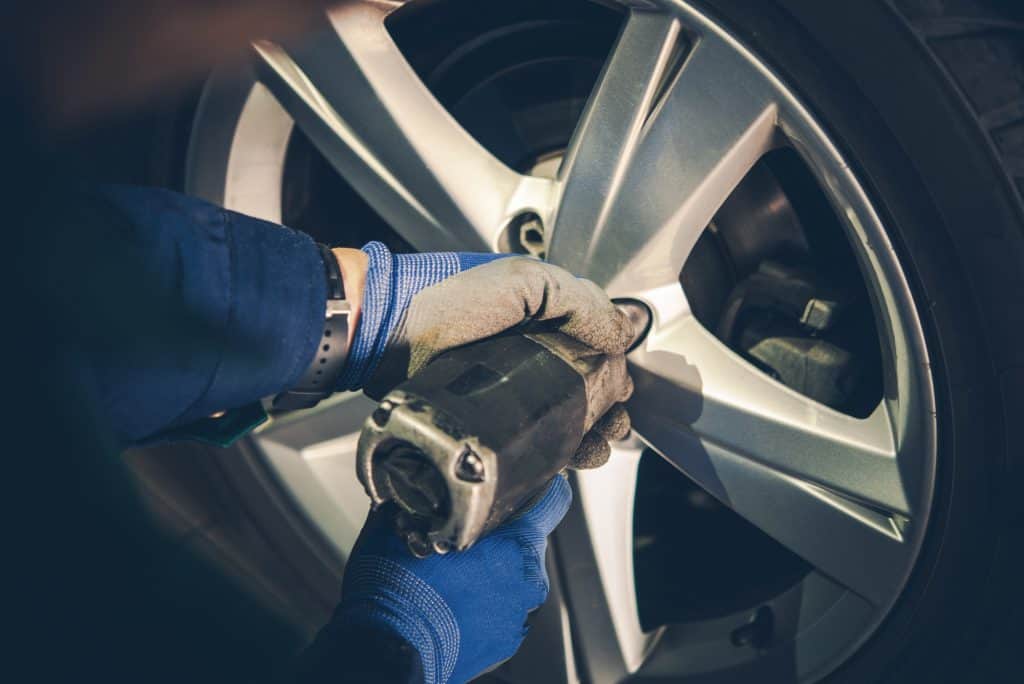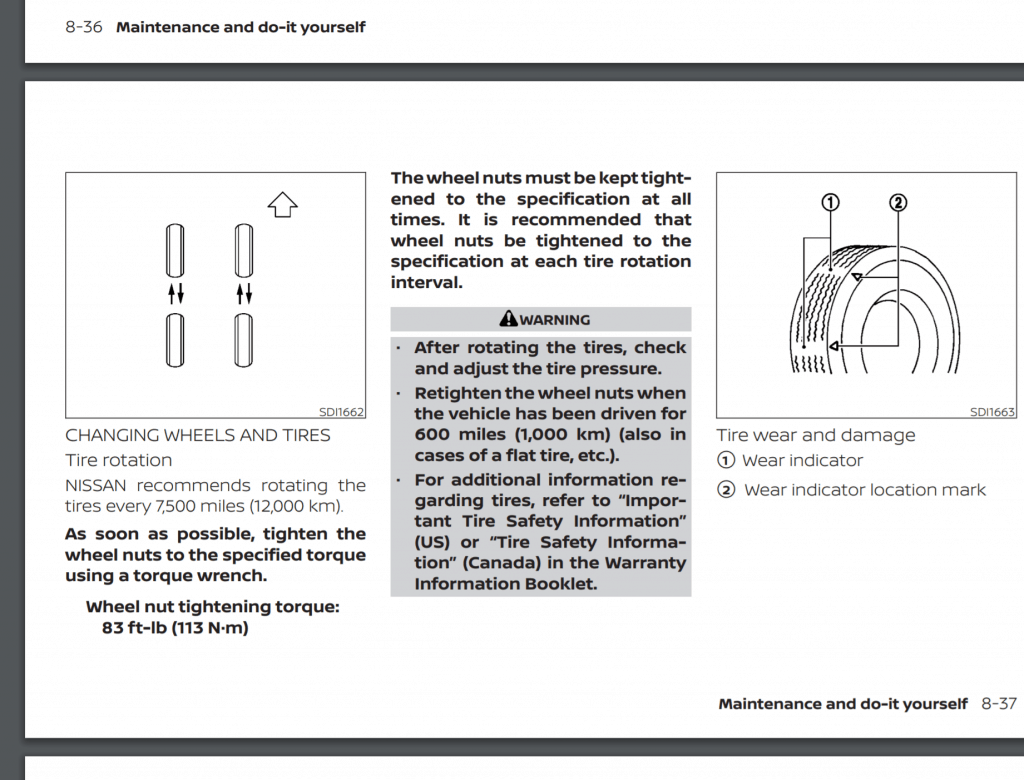Those who have made the switch to a Nissan Leaf or any other electric car will certainly be glad they did when they realize how much easier it is to manage all the maintenance (or lack thereof). There are no oil changes, no belts or chains to snap, no pistons to lubricate, and no combustion chambers housing their tiny little explosions to make the car go.
While the Nissan Leaf is certainly low-maintenance, it absolutely is not “no-maintenance.” There are some things that will always need to be done, and one of those things is going to be the central part of today’s blog — tire rotation. We’ll be talking about the Nissan Leaf’s tire rotation pattern, when to do the tire rotation, and more.
First, let’s get some background on tire rotation; what it is and why it matters.
What is Tire Rotation? Why Does it Matter?

Tire rotation is the process of moving tires from their current position on the front and rear axles of your Nissan Leaf forward or backward, and sometimes across from one side to the other diagonally. Tire rotation is a critical piece of maintenance designed to maximize the tread life of each tire and maintain an even pattern of wear on all four tires.
Most cars on the market, be they electric or gasoline powered are either FWD or RWD, with a load more that are 4WD and AWD. In any event, the natural use of a vehicle — especially FWD and RWD — will result in wear and tear on the tires, but there’s no way for us to guarantee that this wear and tear will be evenly distributed across all four tires. That’s where tire rotation comes in.
By rotating the tires in different patterns according to the tire structure and drivetrain of the vehicle, we can be sure that the tires wear evenly and the car owner can reap the many benefits of the process.
Why Does Tire Rotation Matter?
First and foremost, tire rotation is a matter of road safety. Rotating the tires properly will ensure an even wear on the tread, which above helps to maximize traction. Unevenly worn tires will inevitably create instability in your ride, which is dangerous for the driver of the Nissan Leaf, the passengers inside the car, and for other road users.
One particular problem that tire rotation helps to prevent is known as “tire cupping.” This is where uneven wear in the tire tread creates crater-like indentations on the tires’ surface. The result is that as you’re driving along, the motion of your vehicle starts to feel bouncier as you’re riding on an uneven surface. The faster you go, the more dangerous that it gets.
In addition to the obvious safety factor, there is also a related performance factor to consider. Evenly wearing tires will maintain the right level of traction and control, which makes taking corners both easier and safer. It will make handling in general more balanced, and it will make your vehicle more efficient. A car that performs well is one that is safer (and more enjoyable) to drive.
We touched just now on efficiency, and that’s also a benefit of proper tire rotation and even wear. When wear gets uneven, it creates additional work for the engine to keep the car moving at the right speeds. That imbalance is not only dangerous, therefore, but can also increase your fuel consumption. Proper rotations will keep consumption where it should be.
Finally, rotation is important in order to minimize unnecessary costs for your Nissan Leaf or other vehicle. It’s not practical or safe in most cases to replace just one or two tires on your Nissan Leaf, unless the circumstances happen to be that the remaining tread on the tires you are leaving in place is almost the same as that of the new tires. That does happen, of course, such as if you have an unexpected blowout not long after getting a new set of tires.
In the vast majority of cases, however, it won’t work. That means that without proper rotation and getting uneven tread on your tires, you’d still have to change all 4 at once and replace the full set, which is a waste of money when it’s more-than likely that two of the four tires are actually still usable for another period of time, if only you’d rotate them!
How Often Should You Rotate Nissan Leaf Tires?
The Nissan Leaf Service and Maintenance Guide recommends that your Leaf tires be rotated once every 7,500 miles or 6 month, whichever comes first. That’s a little more than some older cars, which are often recommended to be rotated at the 5,000-mile mark. In general, however, twice a year is about the average covering most cars.
Besides the 7,500-mile rule of thumb, you should also rotate your tires any time that you detect uneven or unusual on one or more of the tires. If it comes earlier than the 7,500-mile mark, then so be it. If you have reason to believe that your alignment is off, you could get a tire rotation and have the alignment checked at the same time.
What is the Nissan Leaf Tire Rotation Pattern?
The Nissan Leaf is quite unusual when it comes to tire rotation patterns. The Nissan Leaf Owner’s Manual (PDF Page 556) indicates that tires should be rotated in the same way as directional tires (see next section for more on tire rotation patterns):

This means switching the front and rear tires directly without any crossing pattern. This is normally reserved for directional tires on high-performance cars because they have a specific rolling direction.
If your Nissan Leaf has directional tires, then you can go ahead and use this pattern, but for most FWD cars, the recommended pattern is the forward cross, which pushes the front two wheels directly back in the same position (front left to rear left; front right to rear right) and then crosses the rear tires moving forward (rear right to front left; rear left to front right).
Below we’ve included information on other patterns:
Tire Rotation Patterns
The 5:10 mark in the below YouTube video shows different rotation patterns, but also read on if you prefer text instead:
- Rearward cross patterns are used for 4WD, AWD and RWD vehicles that have 4 tires of all the same size and do not use directional tires (tires that are only meant to roll in one specific direction).
- X-patterns are used for FWD vehicles like light-duty trucks and sedans. All the tires are moved across diagonally and forward/backward, creating the overall “X” pattern of rotation.
- Forward cross patterns are used for FWD vehicles, too. Tires on the front axle are moved directly back while the rear axle tires are moved forward diagonally to be on the opposite side left/right of the vehicle at the front.
- Rearward cross spare tire patterns are used on 4WD and RWD vehicles that have a full-size spare tire. Adding the 5th tire into the mix means that a different pattern is needed. In this pattern, both rear axle tires are moved directly forward, with the spare going to the right-side rear position. The right front tire moves diagonally back to the rear left, and the left front becomes the spare tire.
- Forward cross spare tire patterns are also used for vehicles with full-size spares, but this time FWD versions. The rear tires move forward diagonally to take up positions at the front on opposite left/right sides. The original right front tire becomes the spare. The original spare is put on the right rear position, and the left front tire is moved directly back to the left rear position.
- Side-to-side patterns are used on high-performance and directional tires when the vehicle has differently sized performance tires on the front and rear axles. They can’t move forward and back because they are different sizes, so they just swap directly left to right and vice versa.
- Front-to-back patterns are used on high-performance and directional tires when all four such tires are the same size. Front left to rear left, and vice versa. Front right to rear right, and vice versa.
Conclusion: Never Skip a Tire Rotation on Your Nissan Leaf
In the end, it’s essential that you never miss a tire rotation on your Nissan Leaf or other electric or gasoline car. Rotation ensures that you get maximum efficiency, a nice performance boost, and most importantly the traction and control that you need to keep you, your passengers and other road users safe.
Get your tires rotated at least every 6 months or 7,500 miles, whichever comes first, but also keep one eye out for damage or unexpected wear on any number of your tires. This will ensure that you get the most out of your tires. When properly rotated, you can end up getting 5,000-10,000 more miles of life from a set of tires than those where rotations are skipped. You’ll at least be able to reach the Nissan guarantee of 50,000 miles.